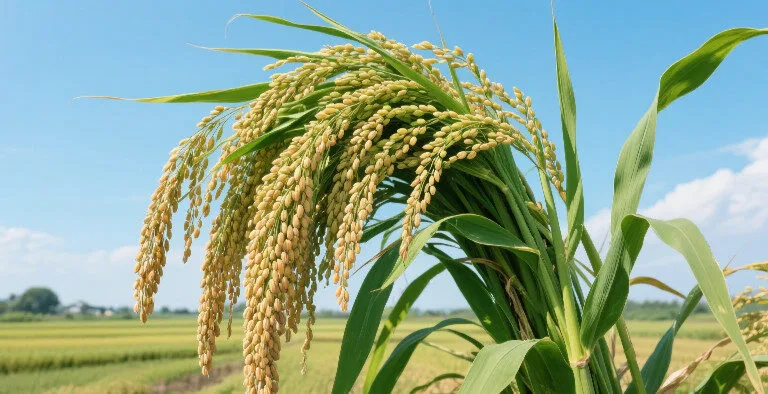In recent years, a remarkable agricultural innovation has captured attention in China: “giant rice,” which stands at an astonishing 2.1 meters tall. With estimated yields ranging from nine to twelve tons per hectare, this variety of super rice has the potential to transform the country’s food production. However, despite its promising characteristics, giant rice has yet to make a significant impact on dinner tables nationwide. This article explores the origins, advantages, and challenges of this innovative crop, as well as its potential role in agritourism.
The development of giant rice is a significant milestone in agricultural science. As traditional rice breeding approaches the upper limit of yield potential, researchers like Xia Xinjie from the Institute of Subtropical Agriculture of the Chinese Academy of Sciences have explored new frontiers. By engineering a hybrid of indica/japonica rice and wild rice, Xia’s team cultivated a variety of rice that stands tall and boasts substantial biomass. In 2017, this achievement was recognized as one of China’s top ten scientific advances. This new variety enhances yield and creates an ecological niche for integrated farming models, such as “rice + N,” in which fish, shrimp, and ducks coexist, contributing to a sustainable agricultural ecosystem. For instance, in 2022, Xinchun Agricultural Company conducted trials in Changsha, Hunan, achieving yields exceeding 850 kg per mu. Pilot sites in Longhui, Shaoyang, Loudi, and Qiandao Lake surpassed 1,000 kg per mu, significantly outperforming conventional rice varieties.
One of the most compelling advantages of giant rice is its ability to adapt to different environments, especially coastal ones. In Yangjiang, Guangdong, a salt-tolerant strain of giant rice demonstrated remarkable resilience. Despite repeated seawater immersion, this variety produced 3.9 tons of rice and over 500 kilograms of shrimp per hectare. This success showcases the potential of giant rice as a climate-resilient solution for regions facing soil salinization and rising sea levels. Additionally, giant rice’s tall stature creates vertical space for aquatic creatures, enabling farmers to adopt integrated farming models such as “rice-shrimp coexistence” and “rice-frog symbiosis.” In Luzhou, Sichuan, the Jiangyang District implemented a double cropping system integrating two rice seasons with shrimp and fish cultivation. This system achieved efficient resource utilization and doubled income from a single field.
Despite its advantages, large-scale cultivation of giant rice faces significant challenges. Industry insiders highlight two critical issues: adaptability to mechanized farming and resistance to lodging. Traditional rice cultivation in China relies heavily on mechanization, but giant rice’s height and thick stems complicate this process. The increased manual labor required for planting and harvesting raises production costs and limits the crop’s scalability. According to data from 2022, Xia Xinjie’s team established over 300 demonstration sites across 20 provinces. However, the total planting area remained below 1,333.33 hectares—a mere fraction compared to China’s vast rice fields, which exceed millions of hectares. Additionally, taller plants are more susceptible to lodging, which is when plants bend or fall over, drastically reducing yields. A study in Sichuan found that giant rice plants suffered lodging rates of up to 30% during heavy winds or rains without genetic improvements, resulting in yield losses of 20–40%. These challenges explain why giant rice remains a niche product despite successful trials.
However, the future of giant rice may lie outside of traditional farming methods. Agritourism integration offers a promising alternative. In Guangzhou’s Zhongluotan Town, for example, the first giant rice base combines ecological farming with educational tourism. It attracts visitors who want to “relax under towering rice ears” and engage in hands-on agricultural activities. By diversifying their income streams through tourism, local farmers generated an additional $450,000 per hectare annually — surpassing the profits from traditional rice farming by 200%. This innovative approach aligns with the growing trend of sustainable and experiential tourism, promoting agricultural education and cultural exchange. Furthermore, in Wenzhou, Zhejiang, a village collective enterprise cultivated giant rice that grew to a height of 2.1 meters, attracting widespread media attention and boosting local tourism as visitors flocked to witness the “forest of rice” phenomenon.
The story of giant rice in China illustrates the intricate balance between scientific innovation, practical challenges, and creative adaptation. While giant rice may not yet dominate conventional farmlands, its success in agritourism shows how modern agriculture is evolving. As demonstrated in Yangjiang, integrating giant rice into saltwater environments enhances food production and revitalizes coastal ecosystems by reducing soil salinity and providing habitats for aquatic biodiversity. As research continues and new applications emerge, giant rice could become a symbol of sustainable, integrated farming, contributing to food security and rural development.
In conclusion, the journey of giant rice, from laboratory research to field cultivation and now into the realm of tourism, showcases the dynamic nature of agricultural advancements in China. Though challenges remain, the exploration and innovation surrounding giant rice offer a glimpse into the future of farming, where science, ecology, and tourism converge to create new possibilities. With ongoing efforts to improve lodging resistance through genetic modification and mechanization adaptations, combined with the proven success of agritourism models in Guangzhou and Wenzhou, giant rice may soon unlock unprecedented opportunities for sustainable growth and prosperity. As we look ahead, integrating giant rice into diverse agricultural models has the potential to transform rural economies and ensure food resilience in an era of climate change.









